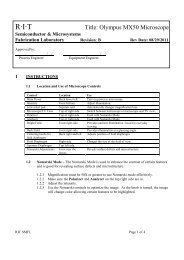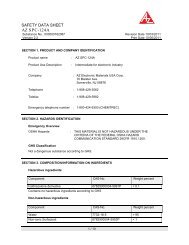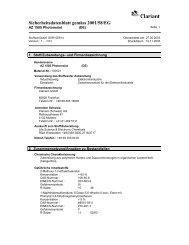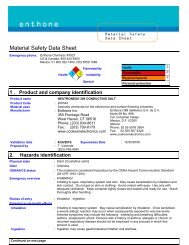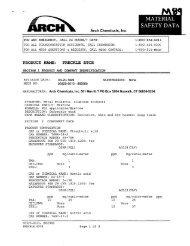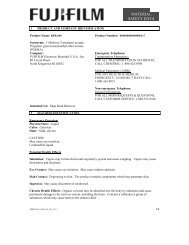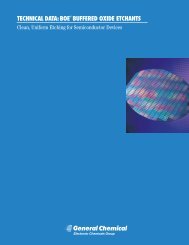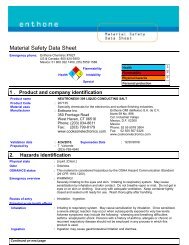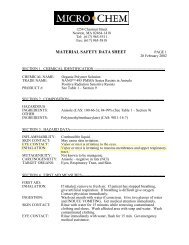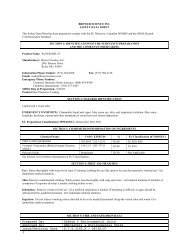0 2 0 Material Safety Data Sheet - SMFL
0 2 0 Material Safety Data Sheet - SMFL
0 2 0 Material Safety Data Sheet - SMFL
- No tags were found...
You also want an ePaper? Increase the reach of your titles
YUMPU automatically turns print PDFs into web optimized ePapers that Google loves.
Insoluble in cold water, hot water. Insoluble in Ammonia. Soluble in dilute Nitric Acid. Slightly soluble in Hydrochloric Acid,Sulfuric Acid.Stability: The product is stable.Instability Temperature: Not available.Conditions of Instability: Incompatible materialsSection 10: Stability and Reactivity <strong>Data</strong>Incompatibility with various substances: Reactive with oxidizing agents, combustible materials, metals, acids.Corrosivity: Non-corrosive in presence of glass.Special Remarks on Reactivity:Incompatible with strong acids, selenium, sulfur, wood and other combustibles, nickel nitrate, aluminum, aluminum trichloride,ethylene, p-dioxan, hydrogen, methanol, non-metals, oxidants, sulfur compounds, aniline, hydrogen sulfide, flammablesolvents, hydrazine, and metal powders (especially zinc, aluminum, and magnesium), ammonium nitrate, nitryl fluoride,bromine pentafluoride, potassium perchlorate + titanium powder + indusorial earth.Special Remarks on Corrosivity: Not available.Polymerization: Will not occur.Routes of Entry: Inhalation. Ingestion.Toxicity to Animals:LD50: Not available. LC50: Not available.Section 11: Toxicological InformationChronic Effects on Humans:CARCINOGENIC EFFECTS: Classified 2B (Possible for human.) by IARC. Classified 2 (Some evidence.) by NTP. Causesdamage to the following organs: skin. May cause damage to the following organs: kidneys, lungs, liver, upper respiratory tract.Other Toxic Effects on Humans:Hazardous in case of inhalation. Slightly hazardous in case of skin contact (irritant, sensitizer), of ingestion.Special Remarks on Toxicity to Animals:Lowest Published Lethal Dose/Conc: LDL [Rat] - Route: Oral; Dose: 5000 mg/kg LDL [Guinea Pig] - Route: Oral; Dose: 5000mg/kgSpecial Remarks on Chronic Effects on Humans: May cause cancer based on animal test dataSpecial Remarks on other Toxic Effects on Humans:Acute Potential Health Effects: Skin: Nickel dust and fume can irritate skin. Eyes: Nickel dust and fume can irritate eyes.Inhalation: Inhalation of dust or fume may cause respiratory tract irritation with non-productive cough, hoarseness, sore throat,headache, vertigo, weakness, chest pain, followed by delayed effects, including tachypnea, dyspnea, and ARDS. Death dueto ARDS has been reported following inhalation of high concentrations of respirable metallic nickel dust. Later effects mayinclude pulmonary edema and fibrosis. Ingestion: Metallic nickel is generally considered not to be acutely toxic if ingested.Ingestion may cause nausea, vomiting, abdominal , and diarrhea. Nickel may damage the kidneys(proteinuria), and mayaffect liver function. It may also affect behavior (somnolence), and cardiovascular system (increased cornary artery resistance,decreased myocardial contractility, myocardial damage, regional or general arteriolar or venus dilation). Chronic PotentialHealth Effects: Skin: May cause skin allergy. Nickel and nickel compounds are among the most common sensitizers inducingallergic contact dermatitis. Inhalation: Chronic inhalation nickel dust or fume can cause chronic hypertrophic rhinitis, sinusitis,nasal polyps, perforation of the nasal septum, chronic pulmonary irritation, fibrosis, pulmonary edema, pulmonary eosinophilia,Pneumoconiosis, allergies (asthma-like allergy), and cancer of the nasal sinus cavities, lungs, and possibly other organs.Future exposures can cause asthma attacks with shortness of breath, wheezing, cough, and/or chest tightness. Chronicinhalation of nickel dust or fume may also affect the liver (impaired liver function tests), and blood (changes in red bloodcell count). Ingestion: Prolonged or repeated ingestion of nickel can be a source chronic urticaria and other signs of allergy.p. 4



